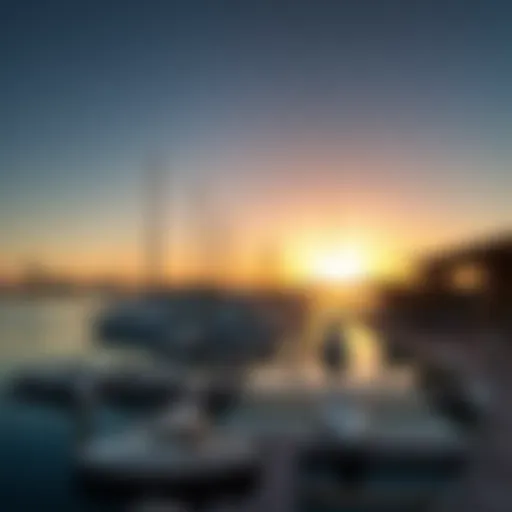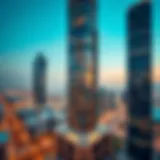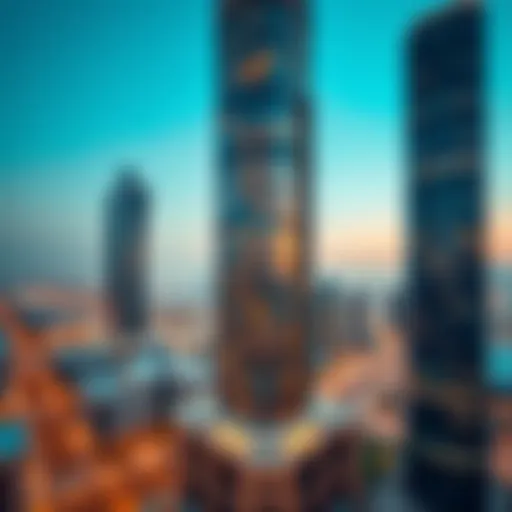Exploring the Iconic Fountain of Dubai: History and Impact
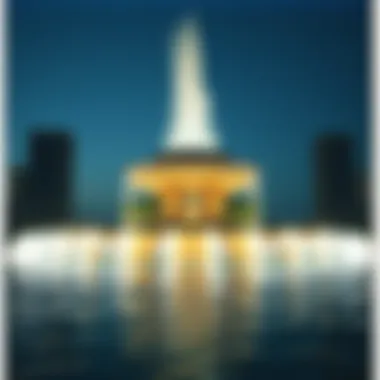

Intro
The city of Dubai is known for its cutting-edge architecture and luxurious lifestyle. Among its many wonders, one standout feature captures the attention of both residents and tourists alike – the Dubai Fountain. This remarkable creation is not just a mere decorative element; it plays a pivotal role in the city’s cultural narrative and economic landscape. The fountain is strategically positioned by the Burj Khalifa and the impressive Dubai Mall, blending seamlessly into the vibrant atmosphere that surrounds these landmarks.
As we dive deeper into this exploration, it becomes clear that the fountain stands as a testament to human ingenuity and artistic vision. It functions both as an environmental showcase and a symbol of Dubai’s rapid urban development. The synergy of water, light, and music creates an experience that enthralls spectators, drawing them into a world of wonder that gently reflects the city’s aspirations.
In the following sections, we will examine the market trends and investment opportunities surrounding the area, emphasizing how this magnificent fountain impacts the broader economic framework of Dubai. Understanding these elements can provide valuable insights for those considering investments in this burgeoning metropolis.
Prelims to the Fountain of Dubai
The Fountain of Dubai stands as a monumental emblem of innovation and artistry in the heart of a city that thrives on ambitious pursuits. As one of the largest choreographed fountain systems in the world, it mesmerizes visitors with its grand displays of water and light, symbolizing not just a technical achievement but a cultural hallmark too. This section delves into the fountain's significance, exploring both its historical roots and its architectural marvels which contribute profoundly to Dubai's identity.
Historical Context
Understanding the Fountain of Dubai requires a look back at the city's rapid transformation from a modest fishing village into a modern metropolis. The fountain was inaugurated in 2009, shortly after the completion of the Burj Khalifa, enhancing the attraction of Downtown Dubai. One could argue that it emerged from Dubai’s desire to augment its image as a global tourist destination, capitalizing on the city's rich blend of tradition and modernity.
The development came at a time when Dubai was positioning itself as a hub of tourism and commerce. The city’s leaders envisioned the fountain as more than just a piece of art; they saw it as a signal of progress and prosperity. Local culture played a significant role in its conception, reflecting aspects of traditional Middle Eastern water features which were historically important for community life. The setting of the fountain, on the artificial lake at the base of the Burj Khalifa, adds to its historical layers, weaving its narrative into the fabric of the community.
Architectural Significance
The architectural design of the Fountain of Dubai is nothing short of a masterpiece that marries form and function. Designed by the renowned WET Design, its structure spans over 275 meters in length, with water jets that shoot up to 150 meters into the air. This feature not only highlights the sophistication of modern engineering but also serves a symbolic role—representing the aspirations of a nation reaching for the stars.
The design incorporates over 6,600 lights and 25 color projectors, producing a stunning visual experience that captures the attention of spectators. This interplay of water and light creates an experience that transcends mere observation; it engages emotions and brings people together, whether they are locals or tourists.
Architecturally, the fountain's circular shape draws inspiration from Islamic design principles, echoing fluidity and harmony found in traditional architecture. The surrounding area—including the Souk Al Bahar and the Dubai Mall—encourages social interaction, fostering connections that go beyond the visual spectacle.
"The Fountain of Dubai ignites the imagination, crafting a narrative that not only celebrates the past but also looks towards a harmonious future."
Ultimately, the Fountain serves as a bridge between the historical and the modern. It epitomizes how Dubai has skillfully blended its deep-rooted cultural heritage with cutting-edge technology, setting an example for cities around the globe on how to design public spaces that inspire awe and community spirit.
Design and Engineering
The design and engineering aspects of the Fountain of Dubai are pivotal to its status as a modern marvel. These elements not only contribute to the fountain's aesthetic appeal but also enhance functionality, creating a remarkable experience for both residents and visitors. By exploring the conceptual framework, engineering achievements, and the harmonious synchronization of water and light, we can appreciate how these components work in tandem to create one of the world's most stunning displays.
Conceptual Framework
At its core, the conceptual framework for the Fountain of Dubai is a blend of art and technology. The design team envisioned a structure that would not merely be a water feature but rather a dynamic expression of culture and innovation. Inspired by traditional Arabic poetry, the fountain's movements mimic the grace of a dancer, captivating audiences with an intricate choreography.
The fountain is thoughtfully positioned on the Burj Lake, which extends a magnificent panoramic view of the Burj Khalifa. Its placement reflects a deeper connection to Dubai's urban landscape, allowing for a narrative that encapsulates the city's rapid growth along with its rich heritage. The strategic design choices—like the fountain's central basin and surrounding architecture—encourage natural viewing spots, making it a communal gathering area.
Engineering Marvel
The engineering marvel that is the Fountain of Dubai is a result of relentless innovation and precision. Spanning over 900 feet in length, the fountain is equipped with 6,600 lights and utilizes over 50 colored projectors. These carefully integrated systems are crafted with advanced technology, enabling the fountain to shoot water jets up to 500 feet into the air.
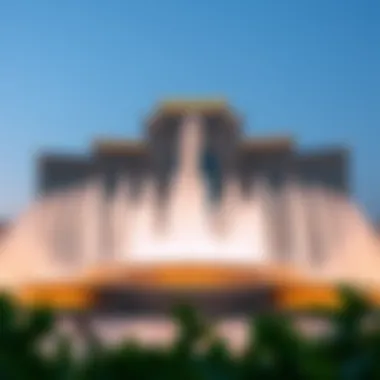

But perhaps one of the most impressive feats is the infrastructure beneath the lake itself. Engineers skilfully devised a system of pumps, jets, and control mechanisms that allow for complex patterns and layers of movement. The water pressure is finely calibrated, ensuring that the performance remains visually breathtaking yet structurally sound. Such meticulous planning illustrates why the Fountain of Dubai is not just simply a tourist attraction; it's a testament to what modern engineering can achieve.
Water and Light Synchronization
In an extraordinary blend of artistry and mechanics, the synchronization of water and light is what truly sets the Fountain of Dubai apart. The fountain features over 1,000 unique water displays, each one harmoniously choreographed with music and light. Every show tells a story, utilizing classical compositions or contemporary tunes that resonate deeply with the audience.
The synchrony is nearly flawless, as computer systems control the timing of both water jets and lighting, creating an immersive experience that dances in rhythm. Audiences often find themselves entranced, losing track of time as they revel in the water’s graceful ebbs and sways.
In summary, the design and engineering of the Fountain of Dubai underscore its significance as a cultural and architectural landmark. The thoughtful conceptual framework, combined with engineering excellence and innovative water-light synchronization, creates an experience that captivates and inspires. It's this synthesis of art, culture, and technology that ensures the fountain remains an enduring symbol of Dubai's evolution as a global city.
Operational Dynamics
Understanding the operational dynamics of the Fountain of Dubai is crucial for grasping its full significance within the city's urban tapestry. This section will elucidate the fountain's daily operations and its adaptability with respect to seasonal variations. Such insights not only benefit casual observers but also attract potential investors and developers looking to capitalize on the fountain's popularity.
Daily Operations
The Dubai Fountain is not simply a visual feature; it is an intricate system operating with precision. This spectacular showcase plays out throughout the day, with performances timed to music across various genres. The regular shows, often occurring every half-hour in the evening, feature a meticulously crafted choreography of light and water that mesmerizes thousands of onlookers.
The efficient machinery behind the scenes is remarkable. It relies on a sophisticated framework of pumps and nozzles that can shoot water up to 150 meters into the air. Each performance is managed by a skilled team that regularly conducts checks on the fountain's infrastructure to ensure everything runs smoothly. This oversight includes routine maintenance every night when the crowds have dispersed.
In terms of impact, the daily operations attract numerous visitors, significantly bolstering tourism. The surrounding areas, filled with restaurants and shops, thrive thanks to foot traffic generated by the fountain's performances. The Fountain of Dubai's operational consistency serves as a catalyst for ongoing engagement with the community. This creates an enduring loop of interest, where visitors are likely to return time and again, further enhancing the local economy.
Seasonal Variations
As the seasons change, so too do the dynamics of the Dubai Fountain's operations. While the fountain generally performs its dazzling shows throughout the year, different seasonal events and festivities influence its programming. For instance, during the festive months of Ramadan, special performances are tailored to celebrate this cultural moment, often incorporating traditional music and thematic elements that resonate with community values.
Moreover, the summers in Dubai, characterized by extreme heat, affect the timing of shows. Operating hours might shift to later in the evening when temperatures are more bearable. Such adaptability ensures that the fountain remains an attraction not just for tourists but also for residents seeking evening activities.
The fountain's operation during holidays and festivals showcases its capacity to evolve with community needs. In essence, the operational dynamics symbolize not just a function of machinery but also represent a core aspect of Dubai’s culture and social gatherings.
"The Dubai Fountain is more than just a sight; it’s a symbol of the city’s commitment to innovation and cultural celebration."
The adaptability and operational strategies employed by the Fountain of Dubai are key elements that influence how effectively it resonates with both residents and visitors. Understanding these dynamics provides valuable insights into the fountain's role as a vital piece of Dubai's urban landscape.
Cultural and Social Impact
The Cultural and Social Impact of the Fountain of Dubai is a rich narrative that weaves through the fabric of the city. This fountain is more than just a dazzling display of water and light; it represents a confluence of various cultural elements and societal shifts in Dubai. For both residents and tourists, the fountain serves as a beacon that not only captures the spirit of the city but also evolves alongside it.
Tourism Magnet
The fountain acts as a tourism magnet, a vital draw for millions who visit Dubai each year. Craftily positioned against the iconic Burj Khalifa, the world�’s tallest building, its charm is hard to miss. Tourists flock to witness its mesmerizing performances, which are synchronized with music ranging from classical to contemporary Arabic. Such heartfelt spectacles create an irresistible experience, compelling visitors to share their adventures across social media platforms.
In practical terms, this influx of tourists translates into significant economic benefits for local businesses. Restaurants, shops, and hotels in the vicinity of the fountain notably see an uptick in business during the fountain shows. A surge in foot traffic means increased sales for establishments that cater to visitors looking to dine or shop before or after the nightly performances. Moreover, the Dubai Fountain plays a crucial role in setting up the tone of the city’s image as a global tourist destination, created through effective marketing and aesthetic appeal.
Additionally, the fountain hosts various cultural events and seasonal celebrations, further enhancing its role as a focal point for tourism. Its versatility allows it to feature in distinct events throughout the year, from celebrating significant national holidays to highlighting local artistry, placing Dubai’s cultural diversity on an international stage.
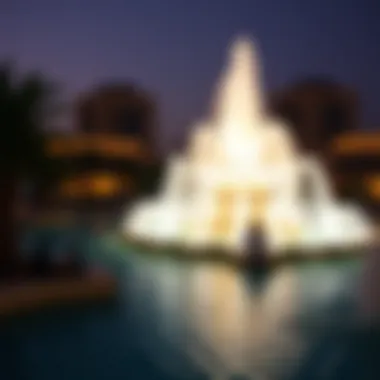

Influence on Community Life
Beyond tourism, the fountain significantly influences local community life. It acts as a gathering space for residents, providing a communal area for families and friends to connect. In a city known for its rapid development and modern living, the fountain delivers a hint of nostalgia and a serene environment amidst the bustling urban life. Locals often frequent the area for leisure, jogging or simply to enjoy the waterfront ambiance.
The fountain also contributes to a sense of identity among residents. This iconic landmark has become a point of reference in local discussions, from "Let’s meet by the fountain" to attempts at capturing the perfect photo with it in the backdrop for social media. Its presence fosters a feeling of pride in the community, becoming a cherished symbol of what Dubai represents—a blend of tradition and modernity.
Furthermore, events centred around the fountain, like charity functions or local festivals, enrich social bonds and community interactions. Such gatherings provide opportunities for dialogue and celebration among diverse cultural backgrounds, showcasing the city's commitment to inclusivity.
In summary, the Cultural and Social Impact of the Fountain of Dubai is far-reaching, resonating within both the local community and the vast array of tourists. With its role as a vibrant locale for tourism and a nurturing environment for community engagement, it undeniably enriches the lives of all who encounter its beauty.
"The fountain is not just water and light; it is where the heart of Dubai beats for both its people and visitors."
For further reading on similar topics, please refer to Dubai's Tourism Overview and The Social Fabric of Dubai.
Investment Perspectives
The Fountain of Dubai serves not just as a breathtaking spectacle but as a pivotal point in the real estate dynamics of the region. Understanding investment perspectives surrounding this landmark can yield sustainable returns for astute investors, attracting those keen on capitalizing on Dubai’s dynamic growth trajectory. The economic landscape of the city has been significantly shaped by the fountain, marking it as a crucial element of urban development that deserves scrutiny.
Real Estate Opportunities Around the Fountain
Proximity to the Dubai Fountain translates into unique real estate opportunities. Properties in the vicinity, particularly those boasting views of the fountain, have seen a substantial appreciation in demand. Investors can explore various types of properties ranging from high-end residential units to commercial spaces that benefit from the foot traffic generated by the fountain’s tourist appeal.
- Residential Units: Luxury apartments within the Burj Khalifa or those in nearby developments like the Dubai Mall Residences offer prime views and direct access to the fountain. Buyers often seek these units, driving up prices but also ensuring a strong rental yield for investors.
- Commercial Spaces: Retail establishments and hospitality ventures see a surge in clientele thanks to the fountain’s popularity. Establishments like Dubai Mall capitalize on this by offering experiences that connect seamlessly with the fountain shows. It’s common for rentals in these areas to reflect the added value of nearby attractions.
- Development Projects: Several new projects are already on the way, aiming to enhance the urban landscape around the fountain. Developers should remain attuned to upcoming approvals and permits, as this can create fertile ground for fruitful investments.
Maintaining a keen eye on the pulse of the real estate market in this area can provide investors with a tangible edge.
Market Trends and Predictions
The future of investment around the Fountain of Dubai appears promising, backed by several key indicators. Understanding the ongoing market trends helps investors make informed decisions. Here’s what to consider moving forward:
- Continued Tourist Influx: With Dubai’s reputation for being a global tourism hub, it’s reasonable to expect that interest in properties near the fountain will persist.
- Rise of Mixed-Use Developments: As urban planning trends evolve, mixed-use developments integrating residential, commercial, and recreational elements will likely gain traction. This holistic approach can maximize returns for investors by creating vibrant living environments.
- Increased Government Support: The UAE government has historically played a supportive role in expanding infrastructure and real estate initiatives. Continued investment in public amenities around the fountain is likely to positively influence property values.
- Technological Integration: Smart home and building technologies are becoming increasingly relevant. Properties near the fountain that integrate these capabilities can stand out in a crowded market, attracting more tech-savvy buyers and tenants.
"Local investors, both individual and institutional, must adapt to transient trends by prioritizing properties that enhance lifestyle experiences, which are in high demand among global investors."
In summary, the Fountain of Dubai emerges as a significant marker not just for its visual allure but as an anchor that holds vast potential for real estate investment. Prospective buyers, investors, and developers should align their strategies with the underlying trends and community developments to unlock the most value.
Sustainability and Future Developments
The conversation around sustainability has become central to urban development, and the Fountain of Dubai is no exception. As the world shifts toward more eco-conscious practices, the fountain exemplifies how aesthetic beauty and environmental responsibility can intertwine. These considerations are not only important for the fountain’s reputation but also hold substantial significance for Dubai's image as a forward-looking city. By addressing eco-friendly practices and contemplating future expansions, this section offers a lens through which we see the intersection of environmental concerns and urban artistry.
Eco-Friendly Practices
In recent years, Dubai has made strides to implement eco-friendly practices at the fountain. For example, water conservation measures are fundamental to its operation. The fountain recycles its water, minimizing wastage and ensuring that each performance showcases its beauty without draining precious resources. Moreover, energy-efficient lighting technologies have been adopted, which reduce the carbon footprint during the dazzling displays. It’s not merely about aesthetics; it’s about having a cleaner, greener city.
- Water Recycling: The fountain uses a state-of-the-art recirculation system to filter and reuse water daily. This system ensures minimal water loss and reduces the need for inflows from external sources.
- LED Lighting: The incorporation of LED fixtures consumes significantly less electricity compared to traditional lighting. This transition renders the light shows more sustainable, lighting up the night sky without burdening the environment.
- Audit of Resources: Regular environmental audits are performed, allowing the management to identify areas for improvement and implement cutting-edge solutions continually.
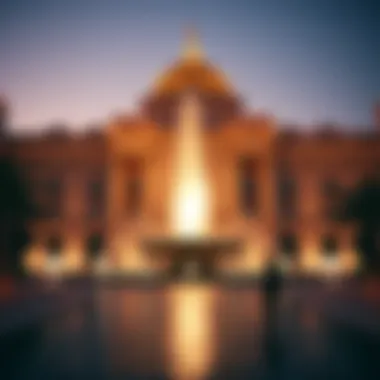

These steps indicate a strong commitment not only to the infrastructure but also to sustainability as a part of Dubai’s ethos. The city's commitment won’t just win hearts; it can sway investors who are increasingly looking to back projects aligned with eco-conscious efforts.
Future Expansion Plans
The future of the fountain not only lies in enhancing its operational efficiency but also in broadening its impact. Future expansion plans are being discussed, which might include interactive elements and augmented reality experiences for visitors. This is particularly interesting for stakeholders like real estate investors who wish to see the integration of innovative technologies that further enhance the visitor experience.
Plans for future developments may focus on:
- Technological Enhancements: Potential collaborations with tech companies could lead to smart features integrated into fountain displays, creating choreographies that respond to real-time audience engagement.
- Cultural Programs: Featuring cultural performances or themed shows can amplify the fountain's role as a community gathering point. Investors might see this as a chance to promote local talent, enriching the social fabric of Dubai.
- Expanded Viewing Areas: Plans to enhance surrounding infrastructure, such as parks or seating areas, could create a more inviting ambiance and encourage longer visits by families and tourists alike. This directly benefits local businesses.
"A future built on sustainability is not merely wishful thinking; it's a necessity for successful living and thriving beyond our current horizons."
By focusing on these future developments, Dubai is not just preserving its iconic fountain but ensuring it remains a vital and dynamic part of the urban experience for generations to come.
Comparative Analysis
In the realm of architectural marvels, comparative analysis plays a pivotal role, especially when examining installations like the Fountain of Dubai. This section aims to illustrate the vital importance of comparing the Dubai Fountain with other iconic fountains around the world. By analyzing similarities and differences, we can uncover insights that extend beyond aesthetics, touching on cultural significance and technological advancements.
Comparative analysis helps ]c inform investors and developers about market trends, while also serving as an educational tool for architects and city planners. Understanding how the Dubai Fountain operates in relation to global counterparts can lead to improved designs and sustainable practices in similar projects.
Global Counterparts of Iconic Fountains
Globally, several fountains stand out due to their unique designs and the impact they have on their locales. Consider the following notable examples:
- The Bellagio Fountains in Las Vegas, USA: Known for their choreographed water shows set against a backdrop of music and lights. This fountain utilizes a similar concept of integrating water display with entertainment, making it a significant tourist attraction.
- The Trevi Fountain in Rome, Italy: Renowned for its Baroque architecture and the tradition of tossing coins into its waters. It reflects a different cultural significance, intertwining art with folklore.
- The Jet d'Eau in Geneva, Switzerland: A symbol of the city, this fountain operates continuously, showcasing a powerful jet of water that reaches heights of up to 140 meters. Its simplicity and effectiveness make it stand out in its tranquil surroundings.
These fountains not only serve a decorative purpose but also contribute to the local economy through tourism. The juxtaposition of Dubai's high-tech fountain system against these iconic figures offers valuable lessons that could influence future developments in urban water features.
"A comparison brings understanding and fosters the potential for innovation."
Learning from International Designs
When examining the designs of fountains across the globe, certain trends and elements emerge that can inform improvements in the Dubai Fountain itself. Noteworthy factors include:
- Water management systems: The efficiency of water circulation and treatment in fountains like the Dubai Fountain could improve through techniques used in other regions. Systems used in the Bellagio Fountains allow for precise control of water displays, minimizing waste and maintaining clarity.
- Integration of technology: The use of advanced lighting and sound systems in various fountains worldwide is something the Dubai Fountain excels at but can continually adapt. The systematic use of LED technology is a lesson planners can draw from—ensuring that innovation doesn’t overshadow architectural integrity.
- Audience engagement: Fountains worldwide often engage audiences directly. Art installations and flower gardens around water features provide immersive experiences. The community might benefit from similar enhancements near the Dubai Fountain to strengthen its cultural and social ties.
End
In this exploration of the Fountain of Dubai, we have stood at the intersection of artistry, engineering, and cultural significance. The fountain isn't merely a spectacle of water and light; it embodies the spirit of a city that continues to reach for the skies. Its carefully orchestrated displays echo the rhythm of Dubai's rapid evolution, revealing layers of meaning that go beyond its stunning visuals.
The Fountain’s Legacy
The legacy of the Fountain of Dubai is deeply interwoven with the identity of the city itself. Like a shining beacon, it attracts countless visitors, creating a vibrant nexus for both tourists and locals. Historically, fountains have signified wealth and prosperity. This fountain, with its remarkable scale and innovative technology, isn't just a statement of extravagance; it marks a milestone in Dubai's transformative journey. Over the years, it has become an integral part of the Dubai experience, a place where families gather, romantic couples stroll, and tourists marvel. Encompassing the essence of celebration, the fountain's legacy will likely ripple through future generations, influencing urban designs and public spaces across the world.
Final Thoughts on Its Role in Dubai's Evolution
As Dubai continues to carve its niche on the global stage, the Fountain serves as both a symbol and a catalyst for the city’s ambitious aspirations. Beyond the technical marvel it represents, it carries profound messages about unity, progress, and sustainability. Investing in and around the fountain has shown potential for real estate growth, evidenced by the flourishing developments nearby. The Fountain of Dubai is more than just a water show; it encapsulates the city’s vision of a connected, progressive urban landscape, where every splash of water tells a story of determination and hope. The evolution of Dubai can be likened to the ebb and flow of the fountain’s waters, forever changing yet undeniably beautiful.
"The Fountain of Dubai is a reflection of the city’s grandeur; a reminder that even amidst rapid growth, the art of tradition can still flourish."
As we look to the future, it's evident that the Fountain of Dubai will not only endure as a remarkable landmark but will also play a pivotal role in shaping the narrative of a city that never ceases to amaze.

